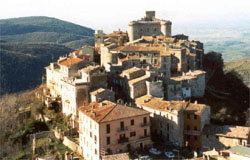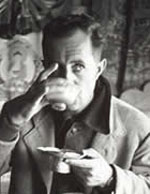Sinological Profiles
Giuseppe Tucci
5 Jun 1894 (Macerata) - 5 Apr 1984 (San Polo dei Cavalieri)Tucci, not to take a lot of time over it, is the great figure of modern Tibetan studies. From his base in Indology and Buddhism (besides Sanskrit, Pali, and Tibetan, he was competent also in Persian and Chinese), he expanded in the direction of Chinese Buddhism and Chinese Buddhist texts.
Tucci's early studies were in San Polo dei Cavalieri, a castle town of 2,300 people, going back to the 10th century and later associated with the Orsini family (whence the "dei Cavalieri"), 25 miles northeast of Rome. Beginning in 1915, he saw military service in World War One, and was discharged with the rank of lieutenant; his Bachelor's degree was awarded in 1919. Tucci was sensitive to the possibilities of spiritual liberation in Eastern religions, and as Italy reinvented itself after the war, looking for a spiritual liberation of its own, he found those possibilities not incompatible with the ideology and program of Italian Fascism, which also believed in inner discipline and spiritual liberation.
He was a supporter of Mussolini, who came to power in Italy in 1922, and a friend of the prolific Fascist philosopher and statesman Giovanni Gentile, who published Studi sul Rinascimento and I Profeti del Risorgimento Italiano in 1923, and who became Minister of Education under the new government in that same year. In 1925, the Mussolini government made a gift of books to Visva-Bharati, the library and study center which Rabindranath Tagore had established in Santiniketan, and also dispatched two scholars: Carlo Formici (in November 1925) and Giuseppe Tucci (a little later). Tucci made this comment on the scene:
Freedom and ananda are the two fundamental principles of the educational ideal of Tagore: That is what he has put into practice in Visva-Bharati, where the student is living his own life, not only in contact with books, but also with his own soul, and with Nature, - a nature infinitely serene as it is in Santiniketan, divinely eloquent in the solitude which inspired the meditation of the Maharshi.
From 1925 to 1930, Tucci taught Italian, Chinese, and Tibetan at Santiniketan and also at the University of Calcutta. He was elected to the Italian Academy (Accademia Nazionale dei Lincei) in 1929. From this period in India come his early publications Pre-Dinnaga Buddhist Texts on Logic from Chinese Sources (Baroda, 1929) and On Some Aspects of the Doctrines of Maitreya (natha) and the Asanga (Calcutta, 1930).
Back in Italy, Tucci taught Chinese language and literature at the University of Naples beginning in 1930. His important volume on the stupa in Tibetan art (Indo-Tibetica I) appeared in 1932, and in that year Tucci became Professor of Indian and Far Eastern Religion and Philosophy at the University of Rome. In 1933, there was founded the Istituto Italiano per il Medio ed Estremo Oriente (IsMEO, in 1995 renamed the Italian Institute for Africa and the Orient, IsIAO), as an official organization to promote cultural relations between Italy and Asia, with Giovanni Gentile as president and Tucci as vice-president. In this period, Tucci conducted expeditions to Tibet in 1933, 1935, 1937 (to Dungkar, in western Tibet, on which he was accompanied by the ethnologist and photographer Fosco Maraini) and 1939. Tucci was also an early student of the Tibetan Bon religion.
Later in 1937, following the Marco Polo Bridge incident and the beginning of the Pacific War, Tucci was sent by the Italian Government to strengthen cultural ties between Japan and Italy. The Italian Cultural Institute was established in Tôkyô, and Tucci traveled around the country giving lectures on Tibet and on racial purity. In books, and in the magazine Yamato, Tucci explained to his new public that he found in Zen a doctrine of freedom echoed in Bushidô and in the practice of war. Success, Tucci held, calls for transcendence of the boundaries of the finite self: only here may one find liberation from the "tyranny of time." Zen and war, then, are both ways to escape from the "the cold rationality and impersonality of the modern age." Maraini, meanwhile, was also in Japan, and beginning in 1938, studied Japanese on a scholarship. He became an ardent disciple of Hokusai, and was presently appointed Reader in Italian at Kyôtô University.
Italy surrendered to the Allies in 1943, but a Fascist Italian government was soon revived at Salo. Maraini was anti-Fascist, and his refusal to support the Salo regime in 1943 led to his and his family's imprisonment by Japan as civil detainees. They were released only with the end of the war in 1945, after an imprisonment which Maraini later made famous in the book Ora Giapponese (1953; translated as Meeting With Japan in 1955). Tucci, having meanwhile returned to Italy, worked at greater liberty. His Indo-Tibetica series continued through its 4th title (7 volumes in all), issued from the Italian Academy in 1942. His other major work of the WW2 years was the three-volume Tibetan Painted Scrolls (Rome 1943), regarded at least by art historians as his masterwork. The political collapse of 1943 produced a long lull, from which at length he would emerge with his prestige fully intact. At war's end, Tucci silently abandoned his earlier interest in a fusion of Zen and European war, preferring to interpret his materials in terms of a larger Asian humanism.
In 1946, he published a popular work, To Lhasa and Beyond. In 1947, three years after the execution of Giovanni Gentile, a reorganized IsMEO resumed its activities with Tucci now replacing Gentile as president, a position he would hold until 1978. He led another archaeological expedition to Tibet in 1948, again accompanied by Maraini. The book Tibetan Folk Songs from Gyantse and Western Tibet followed in 1949. The English-language journal East and West was founded by the Institute in 1950, as a medium for scholarship and archaeological reports in the cultures of the Institute's concern. Tucci's Nepal explorations, in 1952 and 1954, belong to this period, and were followed by still wider campaigns in Pakistan (1956), Afghanistan (1957) and Iran (1959). Further textual studies appeared as Minor Buddhist Texts (Rome, 1956 and 1957). Maraini, meanwhile, became a professor of Japanese at Florence.
In 1957, the year Italy established diplomatic relations with China, there also opened the Museo Nazionale d'Arte Orientale (National Museum of Oriental Art), a more or less autonomous governmental agency with responsibility for all Asian art held in Italy. Its chief holdings are in the arts of India, Pakistan, West Asia, Tibet, China, and southeast Asia, with lesser depth in Japanese and Islamic art. The Museo is the repository for illegally exported Asian art seized by the Italian customs authorities; it is charged to inventory Italian collections of Asian art, and as far as possible to prevent those objects from leaving the country. On more or less permanent loan to the Museum from IsMEO (now IsIAO) are the art objects brought back from Tucci's expeditions, and the massive documentation of those expeditions, including 500,000 photographs and drawings of archaeological sites. Many of the photographs were the work of Maraini.
In 1961, Visva-Bharati conferred on Tucci its highest award, the Desikottama. In 1970 appeared The Religions of Tibet, written in German for a series of studies on religions of Asia (English translation, 1980). The third volume of Minor Buddhist Texts appeared in 1971. In The Theory and Practice of the Mandala (1974), Tucci relied in part on the theories of Jung: yet another spiritual exploration. His interests extended to religious thought throughout Eurasia, from Zarathustra to Confucius.
Honors not inappropriately came to him. He received the Jawaharlal Nehru Award from India in 1977, and in 1979, the recently revived Balzan Prize (the Italian Nobel, first given to the Nobel Foundation in 1961 by the Fondazione Internationale Balzan). The citation for the latter award read: "For his sensational discoveries in the Orient and for his basic studies which aim to prove interdependence in the development of Asian and European civilizations."
Tucci relinquished his presidency of IsMEO in 1978, at the age of 84. Toward the end, in 1984, he was confined to bed with illness for several months. On 3 April, two days before his death, he received the Hungarian medal for the Bicentennial of Alexander Csoma de Korös, that notable explorer of some of the same areas, and his predecessor as a pioneer of Tibetan studies. His scholarship continues to be respected, but it is an explorer that he is most often remembered by the general public.
E Bruce Brooks
Update 2006
On 18 March 2006, the library at San Polo dei Cavalieri was dedicated to the memory of Giuseppe Tucci. The Warring States Project sent this official message of congratulation on that occasion:
To: Luca Mancini
The Warring States Project of the University of Massachusetts at Amherst is pleased to send its greetings and congratulations to the Library of San Polo dei Cavalieri, on the occasion of its being dedicated to the life and work of Giuseppe Tucci. It is good to know that his achievement in establishing Tibetan Studies in the West is being given a permanent memorial, and a place in the remembrance of all scholars of Asia. There is surely no more appropriate place for this memorial than the one in which Tucci spent his last years. May the years of his remembrance now be long, there and elsewhere, in the ages to come.
E Bruce Brooks
Director, Warring States Project
University of Massachusetts at Amherst
References
- Giuseppe Tucci. Indo-Tibetica I: "Mc'od rten" e "Ts'a ts'a" nel Tibet Indiano ed Occidentale, Contributo allo Studio dell' Arte Religiosa Tibetana e del suo Significato (tr as Stupta: Art, Architectonics, and Symbolism)
- Giuseppe Tucci. Indo-Tibetica II: Rin C'en Bzan Po e la Rinascita del Buddhismo nel Tibet Intorno al Mille (tr as Rin-chen-bzan-po and the Renaissance of Buddhism in Tibet around the Millenium )
- Giuseppe Tucci: Indo-Tibetica III: I Templi del Tibet Occidentale e loro Simbolismo Artistico (tr as The Temples of Western Tibet and Their Artistic Symbolism
- Part 1: Spiti e Kuvanar
- Part 2: Tsaparang
- Giuseppe Tucci: Indo-Tibetica IV: Gyantse ed i suoi Monasteri (tr as Gyantse and Its Monasteries)
- Part 1: Descrizione Generale dei Tempi
- Part 2: Inscrizioni: Testo e Traduzione
- Part 3: Tavole
- Donald Lopez (ed). Curators of the Buddha: The Study of Buddhism Under Colonialism (1995)
- Review of the above in Journal of Buddhist Ethics v4 (1997)
- Tucci Centenary Volume (2002)
24 March 2006 / Contact The Project / Exit to Sinology Page



